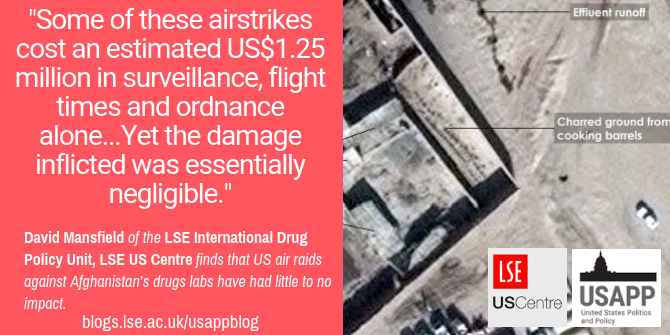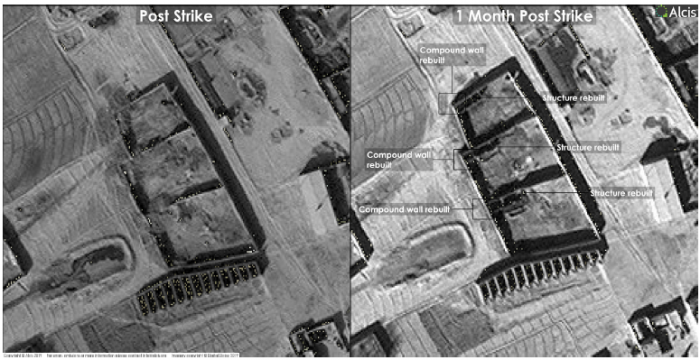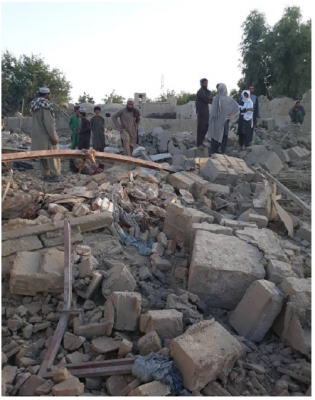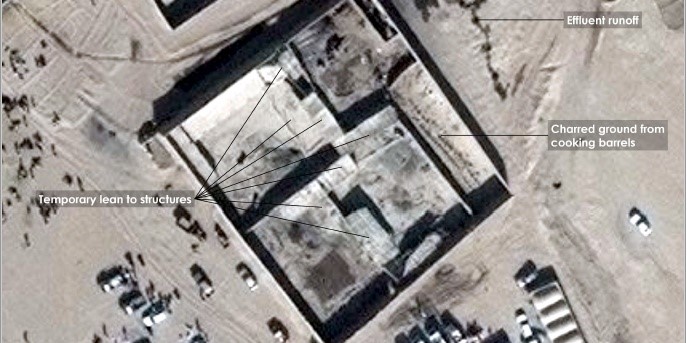In 2017 and 2018 US forces based in Afghanistan mounted air raids against drug processing facilities. While it was hoped that targeting these facilities would starve the Taliban of revenue – much as similar operations against Islamic State in Syria had done previously – new research from David Mansfield concludes that this has not been the case, despite their very high cost. Using a combination of photo and video analysis and on the ground interviews, he finds that most of the targeted labs had been inactive, making their destruction an annoyance, and not a reason for the Taliban to come to the negotiating table.
To many in the west the word “laboratory” conveys an image of scientists in white coats working in a sterile environment with safety goggles, bunsen burners, glass flasks and test tubes. But thanks to the popularity of the series Breaking Bad the phrase “drugs labs” produces a different picture in the mind’s eye; one with much of the same equipment but where processing is conducted in a motor trailer, and where the ubiquitous white lab coat is replaced by a jumpsuit and ventilator.
In Afghanistan a drugs lab is altogether different. These labs are not free from bacteria and contaminants but built from them. The walls are of mud and the floors are dirt; they are the abandoned houses of tenant farmers or sharecroppers, with a make shift lean-too and chemical effluent staining the ground. The flasks and test tubes of a conventional laboratory are replaced by 200 liter steel barrels and plastic bowls. And as opposed to scientists – or former chemistry teachers – the “cooks” in Afghanistan have the most rudimentary knowledge of the periodic table and chemical processes, inputs are rarely weighed and measured and the processing of opiates like morphine and heroin are very much “to taste”. This is definitely more “bake off” than “breaking bad”.
For context, this fascinating video captures cooked opium – chaynaki – being made en masse in a basic lab in Sangeen in northern Helmand. The role of children and unremunerated family labour in cultivation is well known. The video shows the degree to which children are involved in processing and the health risks they are exposed to.

It is these drug processing facilities – or factories, as they are known locally – that the United States Forces -Afghanistan (USFOR-A) decided to mount aerial strikes against in November 2017. The US military believed that such a campaign would replicate the successes the US had achieved in denying revenue to the Islamic State in Syria. There, it was claimed, the destruction of oil refineries and transport routes had almost bankrupted IS, reducing their monthly income by more than 90 percent over 3 years, from $50 million to only $4 million.
The air raids began in Afghanistan on 19 November 2017 and were captured by video and released online by USFOR-A. Over a twelve month period B-52s were flown in from Qatar, F-22s from the United Arab Emirates, and F-35s from aircraft carriers stationed off the Persian Gulf. Other missions were mounted against drug labs from within Afghanistan using drones, rockets and the A-10 Warthog; a plane whose weaponry includes a seven barreled machine gun that fires up to 3,900 armoured piercing rounds per minute – each round the size of a wine bottle.
By August 2018, USFOR-A reported that this combined destructive force had destroyed as many as 200 drugs labs. Further, USFOR-A announced the Taliban had lost as much as US$46 million in revenue from the operation, and that drug trafficking groups experienced a shortfall of more than $200 million. It was argued that the campaign and its impact on the insurgency’s income played its part in forcing the Taliban to the negotiating table.
These were bold claims but there was little evidence to support them. For example, analysis of the videos USFOR-A shared showed that the vast majority of the labs were inactive at the time they were hit. Only one target showed the steel barrels that are ubiquitous to morphine and heroin production, but piled on top of each other the evidence pointed to the fact that this was a fuel depot not a drugs lab. High resolution imagery of as many as 29 of the targets also showed no signs of the steel barrels used for heroin production in the compounds in the post-strike debris (Figure 1).
Figure 1 – Image showing the same drugs lab in Gandam Raiz after being struck in November 2017 and the subsequent rebuild

Furthermore, interviews with those who worked in these labs, or rented their buildings out for drugs production, revealed that these labs were operational for only 50 per cent of the month, and when not processing neither opiates nor acetic anhydride were kept on the premises. An inventory of losses from those whose labs had been destroyed included large and small presses (used to extract residual opiates from solutions), bowls and metal plates, as well as multiple barrels – all of which had been packed up and stored when the airstrike occurred. Only one lab owner reported the destruction of drugs when his lab was struck – a grand total of nine kilograms of opium with a value of US$800 at the time.
Some of these airstrikes cost an estimated US$1.25 million in surveillance, flight times and ordnance alone. The real costs would be much higher were logistics, refuelling and personnel also added. Yet the damage inflicted was essentially negligible. The equipment in a large lab, such as the ones found in Gandam Raiz, in northern Helmand, might be worth as much as US$8,000. The compound and buildings within them, were valued about the same. All a far cry from the kind of losses in revenue USFOR-A reported inflicting on the Taliban and Afghan drug traffickers.
Figure 2 – Destroyed drugs lab in Bakwa district, Farah

Targeting inactive labs USFOR-A had its benefits. It avoided the kind of civilian casualties that were reported in the initial night of the airstrikes in Musa Qala in November 2017, and that had become the subject of considerable rumour and disquiet amongst the Afghan population, particularly in the south. However, destroying inactive labs did not yield the financial damage that USFOR-A looked for in its desire to deny revenues to drug traffickers, and thereby the Taliban. USFOR-A measured the productive capacity of a lab in terms of the number of barrels it contained when active, estimating a loss in revenue to drug traffickers of US$205,000 per barrel. To those running the labs the replacement cost of an empty barrel was at most US$25, and given that a new lab could be up and running in 3-4 days, the destruction of an inactive lab was inconvenient and annoying, but far from a game changer.
The same was true for the Taliban. USFOR-A’s assumed that the Taliban received 20 per cent of the total value of opiates produced, but having destroyed inactive labs the losses- even were this assumption correct – to the Taliban were negligible; not enough to get the insurgents in the room let alone sat at the negotiating table. Moreover, even if the labs active had been active when they were destroyed, the impact on the Taliban’s revenue would have been much less dramatic than USFOR-A claimed. Lab owners reported that the amount the Taliban collected in taxes on opiate production – and the incipient methamphetamine industry – was typically around US$5.00 per kilogram of “powder’ produced and at most 3 per cent of the value of the drugs produced.
By September 2018, the military campaign against drugs labs was abandoned. A new US commander in Afghanistan was appointed who recognised the futility of the effort. Rather than mount a campaign bombing drugs labs that expended large amounts of money on flights and ordnance, risked the lives of military personnel and civilians, and instilled fear in a local population for such a negligible return, the decision was made to target the Taliban directly.
- This article is based on the new LSE International Drug Policy Unit report, ‘Denying Revenue or Wasting Money? Assessing the Impact of the Air Campaign Against ‘Drugs Labs’ in Afghanistan’ [PDF]
- ‘How the US military’s opium war in Afghanistan was lost’ – BBC News – 25 April 2019
Please read our comments policy before commenting
Note: This article gives the views of the author, and not the position of USAPP– American Politics and Policy, nor of the London School of Economics.
Shortened URL for this post: http://bit.ly/2L0pTAD
About the author
David Mansfield – Independent Consultant
David Mansfield is an Independent Consultant. He has been conducting research on rural livelihoods and poppy cultivation in Afghanistan for 23 consecutive growing seasons. He has a PhD in development studies from the School of Oriental and African Studies, London, he is the author of A State Built on Sand: How Opium Undermined Afghanistan, and he is on the editorial board of the Journal of Illicit Economies and Development. David has also worked for the Afghanistan Research and Evaluation Unit since 2005.






Well done, brother David and spot on. The flaw is a systemic one within the US military. Every 9 months, a new officer — hoping to be noticed for promotion — has the “new idea”.
Never mind the fact that people — including within your own Department — have FAR more SUCCESSFUL experience (i.e., Colombia) who try to warn you that your plan is bad. Have to look like the whiz kid to the rating officer.
I could go on but you get the point.
Best,
Andre